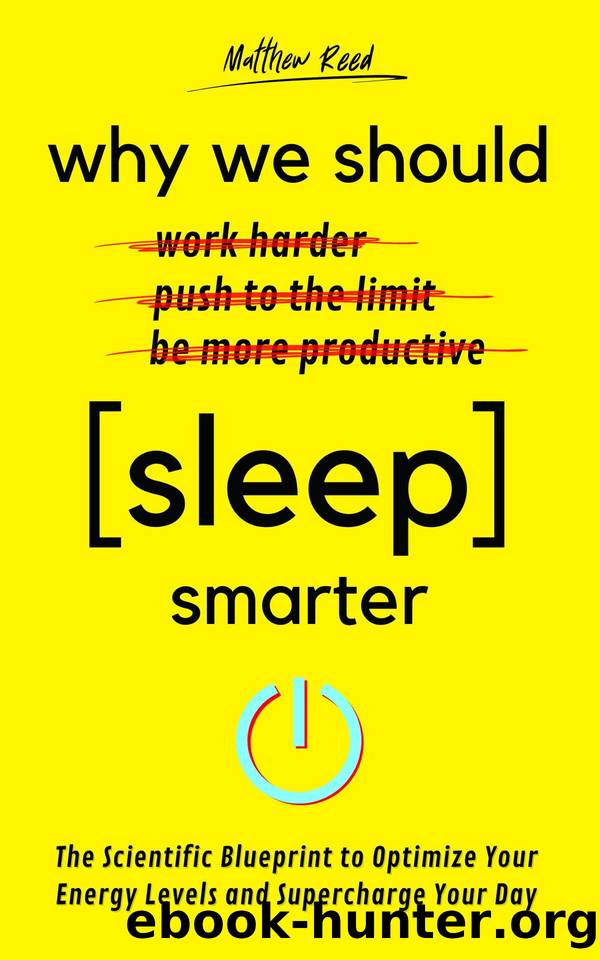Why We Should Sleep Smarter: The Scientific Blueprint to Optimize Your Energy Levels and Supercharge Your Day by Matthew Reed

Author:Matthew Reed [Reed, Matthew]
Language: eng
Format: epub, mobi
ISBN: 9798389691216
Amazon: B0C1J9ZT9Z
Publisher: Independently published
Published: 2023-04-16T00:00:00+00:00
Tool 10: Keep It Cool
For a successful night of sleep, thereâs one aspect we need to ensure: the temperature of our bodies. Now, I know at this point youâre thinking, âMatt, Iâve already done all the above steps, and youâre telling me that my good nightâs sleep is still not guaranteed?â On the contrary, I point out this tool because it may disrupt your sleep during the night.
Rest assured that this tool is equally important. By regulating our bodyâs core temperature, we can fall asleep quicker and avoid being disrupted in the middle of the night. In the hours leading up to sleep, our core body temperature already drops gradually. This is because temperature is a biological signal for the circadian rhythm, which makes melatonin and makes it easier to fall asleep every night (Harding et al., 2019). For effectiveness, we need our bodies to drop their core temperature by 1-3 °F every evening.
This occurs through glabrous skin portals on our bodyâthe face, ears, palms of our hands, and soles of our feetâwhich allow for increased blood flow and regulate heat. It is in these body areas that we can allow for âvasodilation,â or the bodyâs cooling mechanism, to reduce our core body temperature later in the evening (Wong & Hollowed, 2016). These extremities allow for quick heat loss, making it easier to cool down and induce the transition to sleep quicker.
Perhaps itâs best to not skip this step after all?
The core body temperature is around 98.6°F (37°C), but this fluctuates by a couple of degrees in the middle of the night. To ensure that our bodies cool off for a good nightâs sleep, we must make the bedroom temperature range between 60 and 65°F. The last thing you want is for your bedroom to be too hot, as those sweltering conditions will cause sweating and reduce deep slow-wave restorative sleep significantly (Okamoto-Mizuno & Mizuno, 2012).
One method is to have a hot shower or bath before bedtime. Yep, you read that correctly. Itâs because this increase in temperature actually thermoregulates our core body temperature as a result. When we step out of the tub, our bodies begin this natural cooling effect via the glabrous skin areas. This is one perfect way to aid sleep. We can help this cause even more by setting the thermostat, using a fan or air conditioning, keeping the curtains closed at night, opening the windows for air flow, or even using seasonal bedding to fit your needs. Basically, do whatever you can to cool your body down and fall asleep.
Youâll know if youâre not cool enough when you stick a limb out of the bed covers in the middle of the night... and, well, just hope you donât have that scene from Paranormal Activity embedded into your head. Otherwise, youâll find yourself quickly retracting that limb and suffering the rest of the night with nightmares.
Conclusion
All things considered, the tools disclosed in the final critical period form an integral part of a typical evening. When combined together in a night routine, they can be wielded to great effect.
Download
Why We Should Sleep Smarter: The Scientific Blueprint to Optimize Your Energy Levels and Supercharge Your Day by Matthew Reed.mobi
This site does not store any files on its server. We only index and link to content provided by other sites. Please contact the content providers to delete copyright contents if any and email us, we'll remove relevant links or contents immediately.
Men In Love by Nancy Friday(5157)
Everything Happens for a Reason by Kate Bowler(4679)
The Immortal Life of Henrietta Lacks by Rebecca Skloot(4526)
Why We Sleep by Matthew Walker(4361)
The Sports Rules Book by Human Kinetics(4294)
Not a Diet Book by James Smith(3336)
The Emperor of All Maladies: A Biography of Cancer by Siddhartha Mukherjee(3068)
Sapiens and Homo Deus by Yuval Noah Harari(2987)
Day by Elie Wiesel(2720)
Angels in America by Tony Kushner(2596)
A Burst of Light by Audre Lorde(2546)
Endless Forms Most Beautiful by Sean B. Carroll(2431)
Hashimoto's Protocol by Izabella Wentz PharmD(2331)
Dirty Genes by Ben Lynch(2272)
Reservoir 13 by Jon McGregor(2242)
Wonder by R J Palacio(2140)
And the Band Played On by Randy Shilts(2129)
The Immune System Recovery Plan by Susan Blum(2030)
Stretching to Stay Young by Jessica Matthews(2001)
